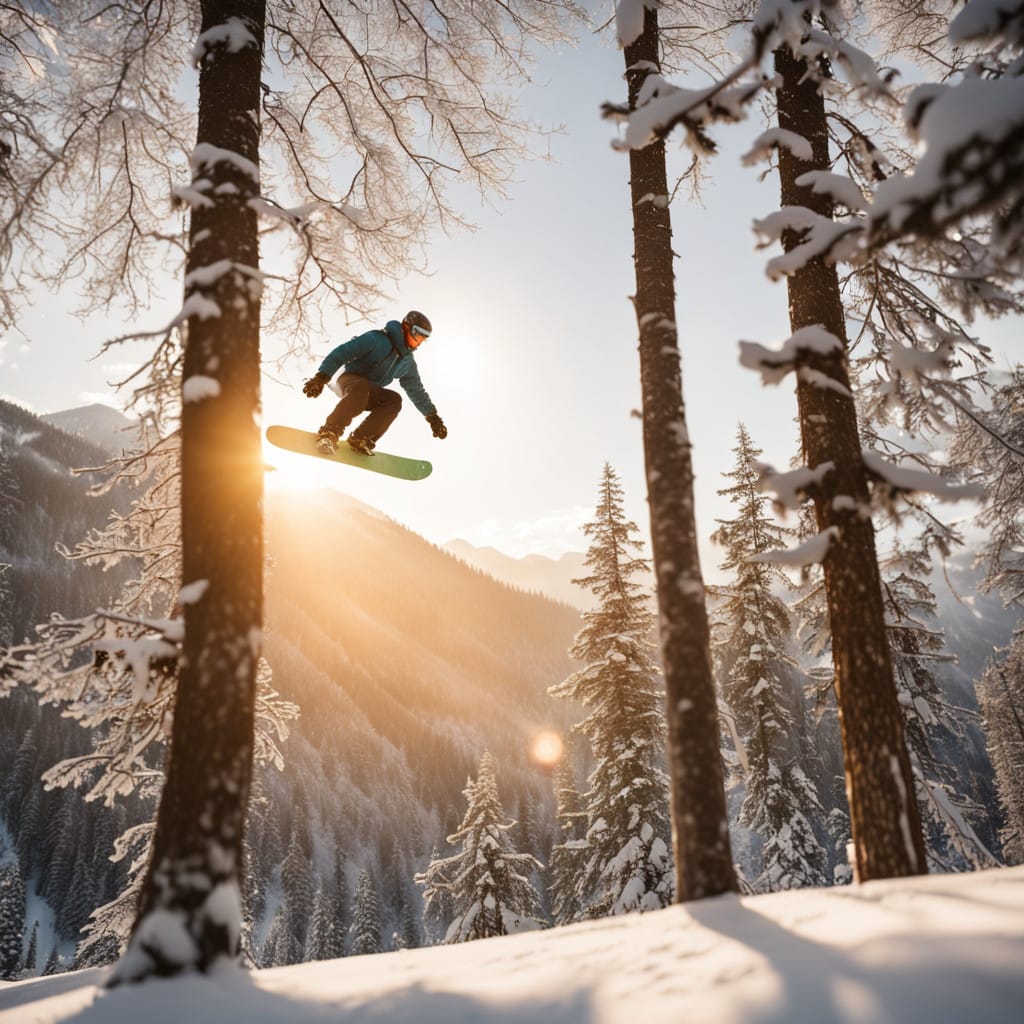Snowboarding
The Exciting World of Snowboarding

Snowboarding, a thrilling winter sport, has captivated audiences and participants worldwide. This adrenaline-fueled activity, which involves descending snow-covered slopes on a board, is a blend of skateboarding, surfing, and skiing. It has evolved from its humble beginnings into a globally recognized sport with professional leagues, competitions, and a massive following.
Origin and History
Snowboarding’s origins can be traced back to the 1960s. Sherman Poppen, an engineer from Michigan, created the first snowboard by fastening two skis together for his daughters. This invention, called the “Snurfer” (a portmanteau of “snow” and “surf”), was the precursor to modern snowboards. Poppen’s Snurfer gained popularity, and by 1966, he had licensed the design to a manufacturer, leading to the sale of over half a million Snurfers by the late 1970s.
In the 1970s, snowboard design underwent significant changes. Dimitrije Milovich, a surfer from the East Coast, began developing snowboards inspired by surfboards. His company, Winterstick, was among the first to produce snowboards commercially. Around the same time, Tom Sims, a skateboard enthusiast, created a “skiboard” in his seventh-grade woodshop class. Sims’ innovations and dedication to the sport played a crucial role in its development.
The late 1970s and early 1980s saw the formation of snowboarding companies that would shape the sport’s future. Jake Burton Carpenter, often referred to as the “father of snowboarding,” founded Burton Snowboards in 1977. Carpenter’s designs and relentless promotion of the sport helped it gain recognition. The introduction of high-back bindings, which provided better control and support, marked a significant advancement in snowboard technology.
Snowboarding faced resistance from ski resorts initially. Many resorts banned snowboards due to concerns about safety and the perceived rebellious nature of snowboarders. However, as the sport’s popularity grew, more resorts began to embrace it. In 1982, the first National Snow Surfing Championships were held at Suicide Six Ski Resort in Vermont, marking a turning point for competitive snowboarding.
The 1990s were a transformative decade for snowboarding. The International Snowboarding Federation (ISF) was founded in 1990 to promote and organize its competitions worldwide. The sport made its Olympic debut at the 1998 Winter Games in Nagano, Japan, solidifying its status as a mainstream winter sport. Snowboarding’s inclusion in the Olympics brought it unprecedented visibility and acceptance.
The Popularity
Snowboarding’s global popularity is undeniable. The sport is enjoyed in countries with snowy winters and mountainous terrains, making it a favorite pastime for winter sports enthusiasts. The United States, Canada, and European countries like Switzerland, Austria, and France are renowned for their snowboarding culture and world-class resorts.
In North America, snowboarding’s popularity surged in the 1990s. Resorts in Colorado, Utah, and California became hotspots for snowboarders. The X Games, an annual extreme sports event organized by ESPN, played a significant role in boosting snowboarding’s appeal. The event showcases top snowboarders performing gravity-defying tricks and stunts, attracting millions of viewers.
Europe, with its rich skiing tradition, quickly embraced snowboarding. Countries like Switzerland and Austria, known for their picturesque alpine resorts, offer some of the best snowboarding experiences. The French Alps, particularly Chamonix and Les Deux Alpes, attract snowboarders from around the globe. European snowboarders, such as Shaun White and Terje Håkonsen, have achieved legendary status in the sport.
Japan is another key player in the snowboarding world. The country’s unique powder snow and mountainous terrain make it a paradise for snowboarders. Resorts like Niseko and Hakuba are famous for their deep powder and vibrant snowboarding communities. Japanese snowboarders, including Ayumu Hirano, have gained international recognition for their skills and contributions to the sport.
Snowboarding has also gained traction in emerging markets. Countries like South Korea, China, and Russia are investing in winter sports infrastructure to attract tourists and develop homegrown talent. The 2018 Winter Olympics in Pyeongchang, South Korea, highlighted the country’s commitment to snowboarding and other winter sports. China’s preparation for the 2022 Winter Olympics in Beijing included the development of new snowboarding facilities and programs to nurture young athletes.
The rise of indoor snow parks has further expanded snowboarding’s reach. Countries with limited natural snowfall, such as the United Arab Emirates and the Netherlands, have built indoor facilities that simulate snowboarding conditions. These parks provide enthusiasts with year-round access to snowboarding, contributing to the sport’s global growth.
Professional Leagues and Competitions
Snowboarding boasts a vibrant professional scene with numerous leagues and competitions worldwide. These events showcase the sport’s top talent and drive its evolution through innovation and performance.
The International Ski Federation (FIS) governs most of the major snowboarding competitions. The FIS Snowboard World Cup, established in 1994, is one of the premier snowboarding events. It features various disciplines, including slalom, giant slalom, halfpipe, and snowboard cross. Athletes compete in multiple events throughout the season, earning points to determine overall champions.
The Winter X Games, organized by ESPN, is a highlight of the snowboarding calendar. First held in 1997, the X Games feature disciplines such as Big Air, Slopestyle, and Superpipe. The event has become synonymous with extreme sports and attracts top snowboarders from around the world. The X Games are known for pushing the boundaries of what’s possible in snowboarding, with athletes often debuting new tricks and techniques.
The Dew Tour, another prominent snowboarding competition, was established in 2008. It consists of summer and winter events, with the winter segment focusing on snowboarding and skiing. The Dew Tour features disciplines like Slopestyle, Superpipe, and Streetstyle. It provides a platform for both established pros and up-and-coming talent to showcase their skills.
The Burton US Open, one of the oldest snowboarding competitions, began in 1982. Founded by Jake Burton Carpenter, the event has a storied history and remains a cornerstone of competitive snowboarding. The US Open features Slopestyle and Halfpipe events, attracting the sport’s elite athletes. The competition is known for its festive atmosphere and commitment to the snowboarding community.
The Olympic Games represent the pinnacle of snowboarding competition. Since its debut in 1998, snowboarding has become one of the most anticipated events at the Winter Olympics. The inclusion of new disciplines, such as Slopestyle and Big Air, has added to the sport’s excitement and appeal. Olympic snowboarding champions often become household names, inspiring the next generation of snowboarders.
In addition to these major events, numerous regional and national competitions contribute to the sport’s ecosystem. Countries with strong snowboarding cultures, like the United States, Canada, and Switzerland, host various national championships and series. These competitions provide a pathway for young athletes to progress to the international stage.
The Political and Social Significance of Snowboarding
Snowboarding’s impact extends beyond the slopes, influencing political and social spheres. The sport has played a role in promoting environmental awareness, fostering inclusivity, and challenging traditional norms.
Environmental sustainability is a significant concern for the snowboarding community. Snowboarders rely on pristine natural environments for their sport, making them acutely aware of climate change’s impact. Organizations like Protect Our Winters (POW), founded by pro snowboarder Jeremy Jones, advocate for climate action and sustainable practices within the industry. Snowboarding brands and resorts are increasingly adopting eco-friendly initiatives, such as using renewable energy and reducing waste, to minimize their environmental footprint.
Snowboarding has also been a force for inclusivity and diversity. The sport’s roots in counterculture have fostered a welcoming atmosphere for individuals from various backgrounds. Initiatives like “Shred Like a Girl” and “Beyond the Boundaries” aim to empower women in snowboarding, addressing gender disparities and encouraging female participation. Adaptive snowboarding programs, designed for athletes with disabilities, have made the sport more accessible. These programs offer specialized equipment and training, enabling adaptive athletes to compete at the highest levels.
The rise of snowboard media has further amplified the sport’s social significance. Snowboarding films, magazines, and social media platforms celebrate the sport’s culture and community. Iconic snowboarding films, such as “The Art of Flight” and “That’s It, That’s All,” showcase breathtaking landscapes and jaw-dropping performances, inspiring viewers and promoting the sport. Social media influencers and professional snowboarders use their platforms to share their experiences, connect with fans, and advocate for causes they care about.
Snowboarding’s inclusion in the Olympics marked a cultural shift, challenging traditional perceptions of winter sports. The sport’s youthful energy and dynamic style contrasted with the more traditional disciplines like skiing and figure skating. Snowboarding’s Olympic debut introduced a new audience to the sport and demonstrated its legitimacy on the world stage. The success of snowboarders like Shaun White and Chloe Kim has helped bridge the gap between mainstream sports and snowboarding’s countercultural roots.
Rules of Snowboarding
Understanding the rules of snowboarding is essential for both participants and spectators. Snowboarding encompasses various disciplines, each with its specific rules and guidelines.
Freestyle Snowboarding: This discipline includes events like Halfpipe, Slopestyle, and Big Air. In Halfpipe, riders perform tricks on a U-shaped ramp, while judges score based on amplitude, difficulty, execution, and overall impression. Slopestyle involves navigating a course with jumps, rails, and other obstacles, with riders judged on creativity, execution, and difficulty. Big Air focuses on a single jump, where riders perform their best tricks to impress judges.
Alpine Snowboarding: This discipline includes events like Parallel Giant Slalom and Parallel Slalom. In these events, riders race down a course with gates, similar to alpine skiing. The goal is to complete the course in the fastest time while navigating the gates correctly. Head-to-head races add an element of strategy and competition.
Snowboard Cross: Also known as Boardercross, this event involves multiple riders racing simultaneously down a course with jumps, berms, and other obstacles. The first rider to cross the finish line wins. Snowboard Cross is known for its high-speed action and physicality, making it a thrilling spectator sport.
Safety Rules: Safety is paramount in snowboarding. Riders must wear appropriate gear, including helmets, goggles, and protective clothing. Resorts often have designated areas for beginners, intermediate, and advanced riders to ensure safety and minimize collisions. Adhering to the Skier’s Responsibility Code, which includes guidelines for behavior on the slopes, is crucial for maintaining a safe environment.
Etiquette: Snowboarding etiquette promotes respect and consideration among riders. Yielding the right of way to downhill riders, avoiding stopping in narrow or blind spots, and respecting signage and closures are fundamental aspects of snowboarding etiquette. Following these guidelines ensures a positive experience for everyone on the mountain.
Snowboarding, with its rich history, global appeal, professional leagues, and cultural impact, continues to evolve and inspire. Whether you’re a seasoned pro or a curious beginner, the sport offers something for everyone. Embrace the thrill, respect the rules, and join the global community of snowboarders who live for the slopes.






